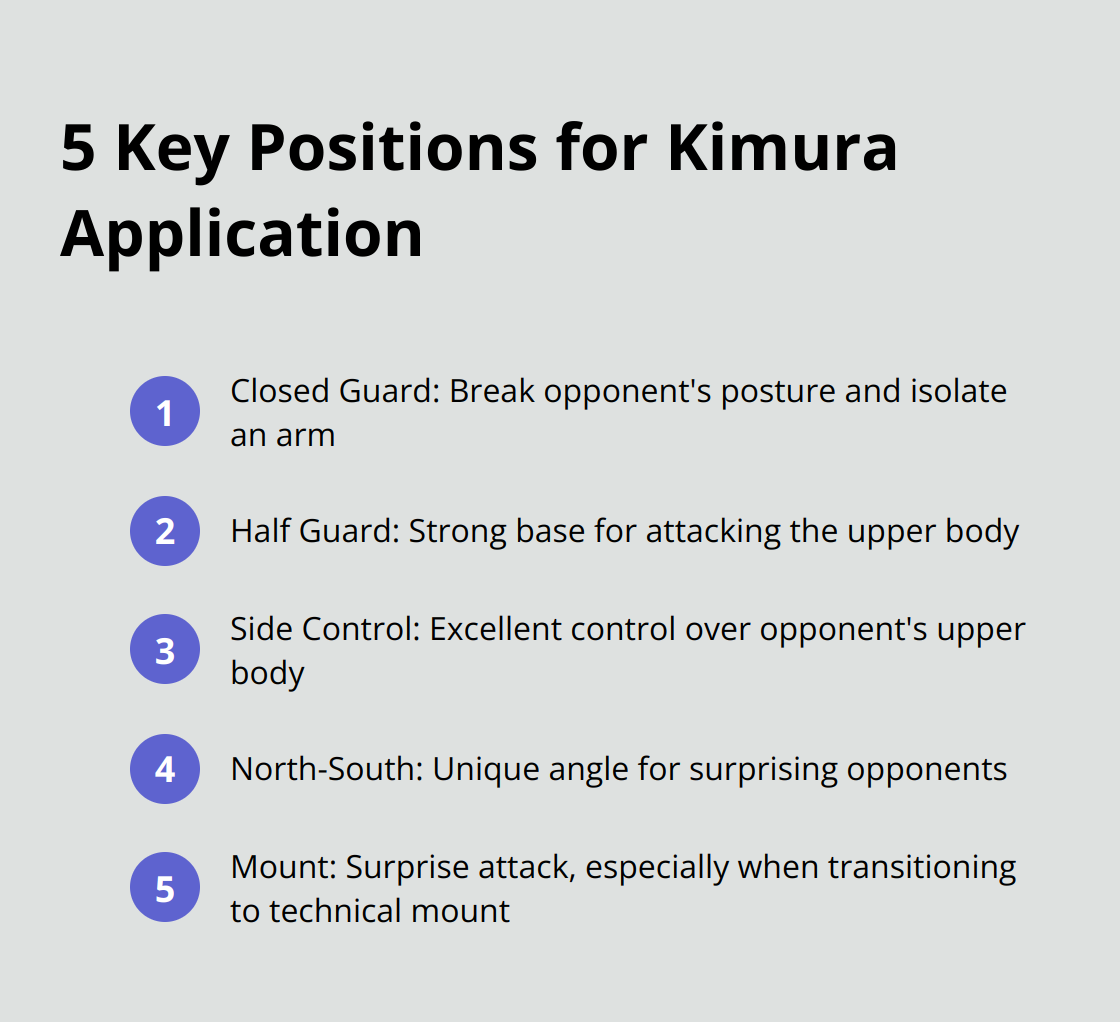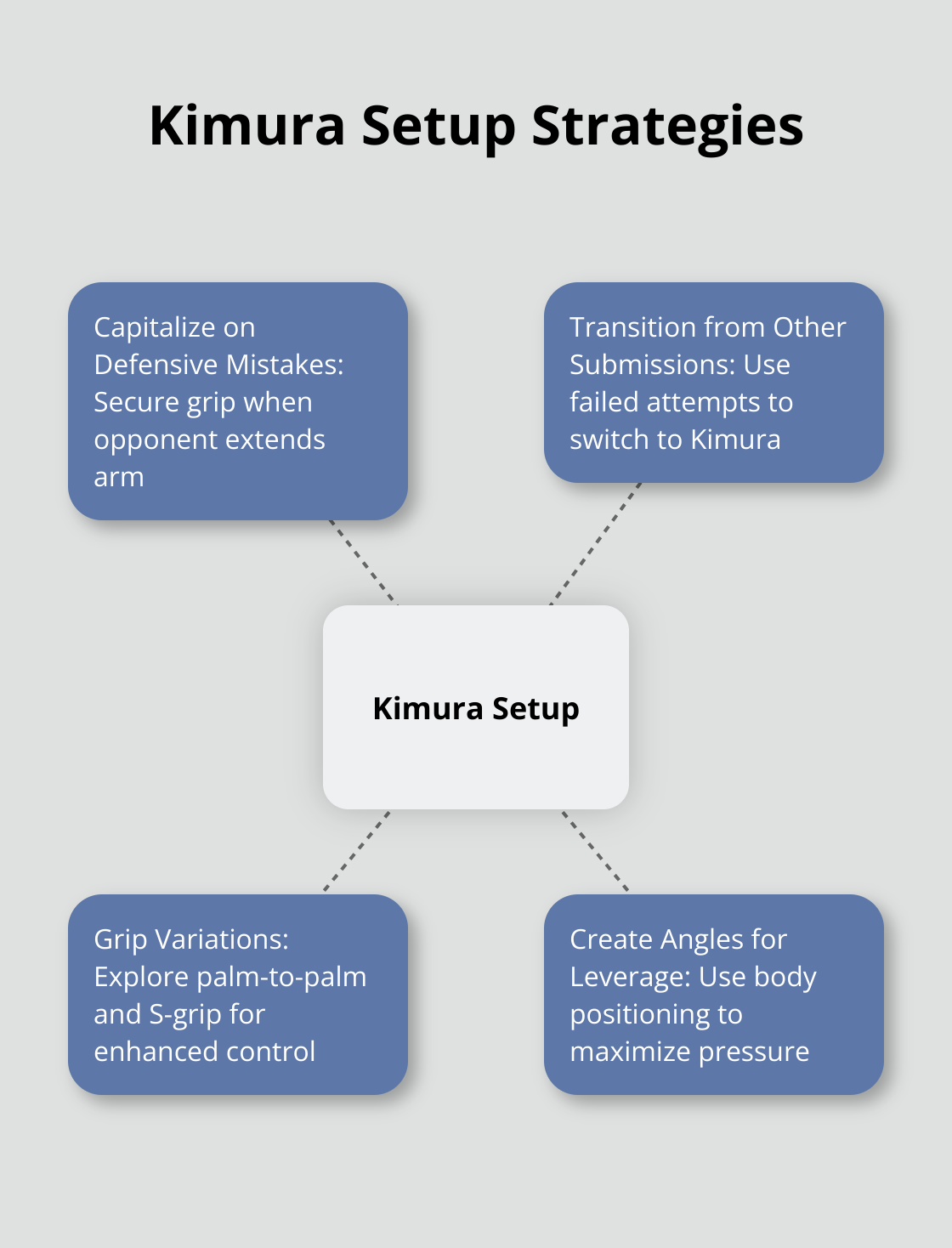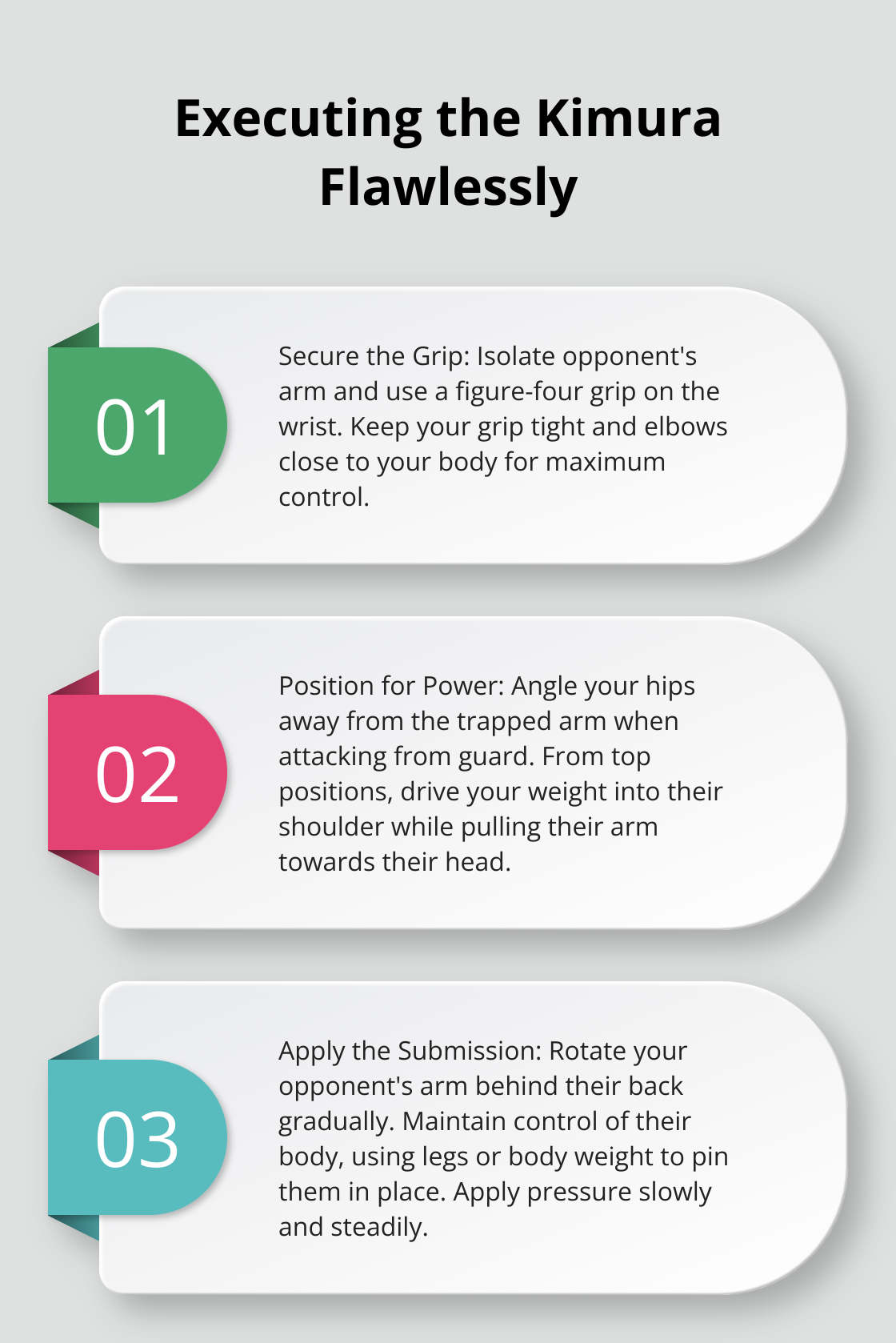The Kimura submission is a powerful technique in Brazilian Jiu-Jitsu, capable of ending matches swiftly and decisively. At Jiu jitsu, we’ve seen countless practitioners harness this move to dominate their opponents on the mat.
Named after the legendary Masahiko Kimura, this shoulder lock has become a staple in both gi and no-gi grappling. In this guide, we’ll break down the mechanics, setups, and execution of the Kimura jiu jitsu technique to help you add this formidable weapon to your arsenal.
What is the Kimura Submission?
Origin and Evolution
The Kimura submission stands as a powerful shoulder lock in Brazilian Jiu-Jitsu. Its name honors the legendary Japanese judoka Masahiko Kimura, who famously used this technique in a fight against Helio Gracie. The fight was set for Rio de Janeiro on October 23, 1951, in what would be a three 10 minute round fight. This historic match introduced the technique to the Gracie family, who then incorporated it into their grappling system.
Mechanics of the Shoulder Lock
The Kimura targets the shoulder joint, specifically the rotator cuff muscles and the glenohumeral joint. When applied correctly, it places immense stress on these structures, forcing the opponent to submit or risk injury. The technique works by externally rotating the shoulder beyond its normal range of motion while simultaneously applying pressure to the elbow and wrist.
To execute the Kimura, the attacker secures a figure-four grip on the opponent’s arm (one hand grasping the opponent’s wrist and the other hand securing their own wrist). This grip allows for maximum control and leverage, enabling even smaller practitioners to effectively submit larger opponents.
Key Positions for Application
The Kimura’s versatility shines through its applicability from various positions:
- Closed Guard: From the bottom, the attacker breaks the opponent’s posture and isolates an arm to initiate the Kimura.
- Half Guard: This position provides a strong base while attacking the upper body, making it ideal for the Kimura.
- Side Control: The top position offers excellent control over the opponent’s upper body, facilitating the Kimura setup.
- North-South: This dominant position provides a unique angle for applying the Kimura, often surprising opponents.
- Mount: While less common, the Kimura can be a surprise attack from the mount, especially when transitioning to technical mount.

Grip Variations and Control
The classic Kimura grip proves highly effective, but several variations can enhance control and submission potential. The “Kimura trap” system (developed by David Avellan) uses the Kimura grip as a control position to set up sweeps, transitions, and other submissions. This system has gained popularity in both BJJ and MMA due to its versatility and effectiveness.
Mastering the Kimura also requires developing strong grip strength. Exercises like farmer’s walks and towel pull-ups can significantly improve your ability to maintain control during the submission attempt.
As we move forward, we’ll explore the various setups and entries for the Kimura submission, providing you with a comprehensive understanding of this powerful technique.
Setting Up the Kimura: Key Strategies
Capitalizing on Defensive Mistakes
One of the most common entry points for the Kimura comes from capitalizing on your opponent’s defensive errors. When an opponent extends their arm to post or frame, they create an opening for you to secure the Kimura grip. This opportunity often presents itself when you pass guard or transition between positions.
Transitioning from Other Submissions
Another effective strategy uses the threat of other submissions to set up the Kimura. For example, when you attempt an armbar from guard, your opponent might defend by pulling their arm back. This defensive reaction creates a perfect opportunity to switch to a Kimura grip. Failed triangle choke attempts can also transition seamlessly into Kimura attacks.
Grip Variations for Enhanced Control
While the traditional figure-four grip proves highly effective, exploring grip variations can enhance your control and submission success rate. The “palm-to-palm” grip (where you clasp your hands together instead of grabbing your own wrist) can provide additional leverage in certain situations. Another variation is the “S-grip,” where you interlock your fingers, which can be particularly useful when attacking from bottom positions.
To maximize the effectiveness of your grip, keep your elbows close to your body. This not only increases your strength but also makes it harder for your opponent to break your grip or escape the position.
Creating Angles for Maximum Leverage
The key to a successful Kimura lies in creating the right angles. Instead of relying solely on arm strength, use your entire body to generate leverage. When you attack from the guard, angle your hips away from the trapped arm. This simple adjustment significantly increases the pressure on your opponent’s shoulder.
From top positions like side control, drive your weight into your opponent’s shoulder while simultaneously pulling their arm towards their head. This combination of pressure and leverage makes the submission much more difficult to resist.
The Kimura is not just a submission but also a powerful control position. Even if you can’t finish the submission immediately, maintaining the Kimura grip allows you to control your opponent’s upper body, setting up sweeps, transitions, or other attacks.
As you master these setup strategies, you’ll significantly increase your success rate with the Kimura submission. Regular practice of these techniques in your training sessions will refine your skills and develop a deeper understanding of this versatile technique.

Now, let’s move on to the execution phase of the Kimura submission, where we’ll break down the step-by-step process to secure this powerful hold.
How to Execute the Kimura Flawlessly
Secure the Grip
The foundation of a successful Kimura lies in the grip. Start by isolating your opponent’s arm, typically by trapping it between your arm and torso. To perform the kimura, fighters isolate the elbow and shoulder joints using a figure-four grip on the wrist. Using this grip, you control your opponent’s arm effectively. Keep your grip tight and your elbows close to your body for maximum control.
Position for Power
After securing the grip, position your body for optimal leverage. When attacking from the guard, angle your hips away from the trapped arm. This creates space and increases pressure on your opponent’s shoulder. From top positions (like side control), drive your weight into their shoulder while pulling their arm towards their head. This combination of pressure and leverage amplifies the submission’s effectiveness.
Apply the Submission
To finish the Kimura, rotate your opponent’s arm behind their back gradually. Maintain control of their body throughout this process. Use your legs or body weight to pin them in place, preventing them from rolling or escaping. As you rotate their arm, keep it close to their body to maximize pressure on the shoulder joint. Apply the pressure slowly and steadily, allowing your opponent time to tap before risking injury.

A common mistake is to rush the submission. This often leads to loss of control and allows your opponent to escape. Instead, focus on maintaining position and gradually increasing pressure. Control is more important than speed when executing the Kimura.
Counter Defensive Reactions
Experienced opponents will attempt various defenses against the Kimura. One common defense is for them to clasp their hands together, preventing you from rotating their arm. To counter this, use your body weight to break their grip. Alternatively, transition to a different submission or use the Kimura grip to sweep your opponent.
Another defensive tactic is for your opponent to roll away from the submission. Anticipate this by following their movement, maintaining your grip, and using their momentum to take their back or transition to a more dominant position.
Refine Your Technique
Mastering the Kimura takes time and consistent practice. Focus on perfecting each step of the execution process, from securing the grip to applying the final pressure. Try to incorporate the Kimura into your rolling sessions regularly. Pay attention to the finer details of the technique, such as the angle of your grip and the positioning of your body relative to your opponent.
At Souza Grappling Co., we emphasize the importance of proper technique to ensure both effectiveness and safety when applying this powerful submission. Our expert trainers provide guidance on executing the Kimura flawlessly, helping students develop a deep understanding of body mechanics and leverage principles.
Common Mistakes to Avoid When Executing the Kimura
While the Kimura is a powerful submission, there are several common errors that can hinder its effectiveness. Being aware of these mistakes will help you refine your technique and increase your success rate:
- Losing control of the opponent’s body: Many practitioners focus solely on the arm, neglecting to control their opponent’s body. This allows the opponent to escape or counter. Always ensure you’re maintaining pressure and control over your opponent’s torso.
- Rushing the submission: Applying the Kimura too quickly often leads to loss of control. Instead, focus on gradually increasing pressure, allowing you to adjust your position and respond to your opponent’s defense attempts.
- Improper grip placement: A common error is placing the grip too close to the opponent’s hand rather than near the wrist. This reduces leverage and makes the submission easier to escape. Always aim to secure your grip as close to the opponent’s wrist as possible.
- Failing to break the opponent’s posture: When attacking from guard, failing to break your opponent’s posture can make it difficult to secure and finish the Kimura. Ensure you disrupt their balance before attempting the submission.
By avoiding these common pitfalls, you’ll significantly improve your Kimura technique and increase your chances of successfully applying this powerful submission.
Final Thoughts
Mastering the Kimura submission in Jiu-Jitsu demands dedication, practice, and a thorough grasp of body mechanics. This powerful technique can transform your grappling arsenal when executed correctly. Proper grip, body positioning, and leverage will significantly boost your success rate with the Kimura.
The Kimura grip serves not only as a submission but also as a control position, creating opportunities for sweeps, transitions, and other attacks. Integration of the Kimura into your overall game plan will make you a more well-rounded and unpredictable grappler. Regular drilling and practice are essential to refine your skills and develop muscle memory.
The Kimura is not just a standalone technique but a gateway to a variety of related submissions and transitions. For instance, the Kimura grip can be used to set up the Armbar, providing an alternative if your opponent defends the initial Kimura attempt. Similarly, the Omoplata shares some mechanical principles with the Kimura, targeting the shoulder joint from a different angle. Understanding these connections will expand your submission arsenal and make your Jiu-Jitsu game more dynamic and unpredictable.
At Souza Grappling Co., we offer comprehensive instruction in a supportive environment to help you perfect your Kimura jiu jitsu technique (and other fundamental skills). Our classes cater to all skill levels, from beginners learning the basics to experienced practitioners aiming to refine their techniques. Join us to enhance your understanding of leverage, control, and body mechanics in Jiu-Jitsu.
Ready to add the Kimura to your BJJ arsenal? At Souza Grappling Co., we’re passionate about helping grapplers of all levels master powerful submissions like the Kimura. We invite you to experience our expert instruction firsthand with a free trial class. During this session, you’ll have the opportunity to drill the Kimura and other fundamental techniques under the guidance of our experienced instructors. Don’t miss this chance to elevate your game – sign up for your free class today and start your journey towards Kimura mastery!




